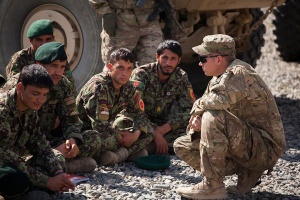After the U.S. leaves Afghanistan, then what?
In talk, MIT professor examines the implications of the military drawdown for regional rivals India and Pakistan.

Political Science Professor Vipin Narang
Image: Stuart Darsch
After more than a decade of involvement, the U.S. has pledged to draw down its Afghanistan troops in 2014, a move with major security implications for both countries. The change will also have a direct impact on two other countries: India and Pakistan, whose regional rivalry has long complicated the situation in Afghanistan.
But what exactly will that impact be, and how concerned should outsiders be that an altered Afghanistan will escalate India-Pakistan tensions? In a talk on Tuesday, an MIT political scientist outlined a scenario whose subtle dynamics might bode well for regional stability: Hard-line ideologues in Afghanistan may well gain influence, but if so, that could act as an outlet for the pressures that have built up between the countries.
“I’m pessimistic about the future of Afghanistan, but I’m a little more optimistic about what this means for the India-Pakistan relationship,” Vipin Narang, an assistant professor of political science at MIT, said in his remarks.
To be clear, Narang stated, the planned U.S. pullout will almost certainly lead to a renewed effort by India and Pakistan to exert more regional influence in Afghanistan.
“The direct competition between India and Pakistan was held at bay with the U.S. invasion and presence of NATO forces the last 14 years,” Narang said, adding: “The drawdown will create a vacuum now where Pakistan and India, I think, re-engage in a more overt proxy competition and vie for influence in Afghanistan.”
In asserting influence over Afghanistan, Narang observed, “Pakistan will probably have an advantage.” However, he added, greater Pakistani influence in Afghanistan does not constitute “an existential threat” to India, but could moderate Pakistani concerns over India’s regional ambitions: “To the extent that Pakistan is relieved of the [fear] that India will threaten it in Afghanistan, it can move forward” with normalizing its relationship with India.
Network advantage?
Narang’s talk, “The Impact of the U.S. Drawdown on India-Pakistan Relations,” was sponsored by MIT’s Security Studies Program, part of an ongoing series of events called, “After 2014: What Next for Central and South Asia?”
The White House has pledged to reduce its troop commitment in Afghanistan during 2014, although it is still considering different proposals. The so-called “zero option” would almost totally remove troops from the country, while other plans call for up to 10,000 troops to remain in Afghanistan.
The stakes are high in all matters of India-Pakistan relations, since both countries are equipped with nuclear arsenals, and have engaged in multiple military skirmishes since the partitioning of India and Pakistan in 1947.
Narang, in describing the modes of influence in Afghanistan, said that Pakistan has a “network advantage” because of its historical relationships among social groups, as well as the active presence of Pakistan’s Inter-Services Intelligence (ISI) agency. India, Narang added, has a “structural advantage” and has used its economic clout to help rebuild infrastructure and develop education in Afghanistan.
Still, Narang suggested, “in a battle between network advantage and a broader structural advantage,” Pakistan’s network advantage would win out.
“The Indians are going to end up having to cede Afghanistan to the Pakistanis and ISI,” he said.
But if that happens, it could create a thaw in India-Pakistan relations on a few fronts, including resolution of a military conflict in the Karakorum Mountains, where hostilities broke out in the 1980s (although a cease-fire has been in place for about a decade). Moreover, Narang proposed, a larger Pakistani hand in Afghanistan means that “militant groups in Pakistan could play less of a veto role in the normalization process between India and Pakistan.”
During an extensive question-and-answer session, Narang fielded a couple of dozen queries and comments from audience members, some of whom suggested additional paths that the India-Pakistan relationship could take, including continued involvement by India in Afghanistan.
Thomas W. Simons Jr., a former U.S. ambassador to Pakistan and a foreign service officer from the 1960s to the 1990s, suggested that “there’s a role for India” in post-2014 Afghanistan precisely because of the likely weakness of the state itself; in this scenario, a continued Indian presence in Afghanistan, supplementing state activities, might help limit the Taliban’s authority.
“Everybody’s going to have an interest in stabilizing a weak Taliban in Afghanistan,” Simons said.
Overall, Narang noted, optimism for the improvement of India-Pakistan relations also has to stem from a recognition of larger mutual interests, including the social and financial price of the ongoing conflict.
“The two governments really don’t have an interest in continuing the historical enmity, because it comes with significant economic and security costs,” Narang said.
Reprinted with permission of MIT News.
